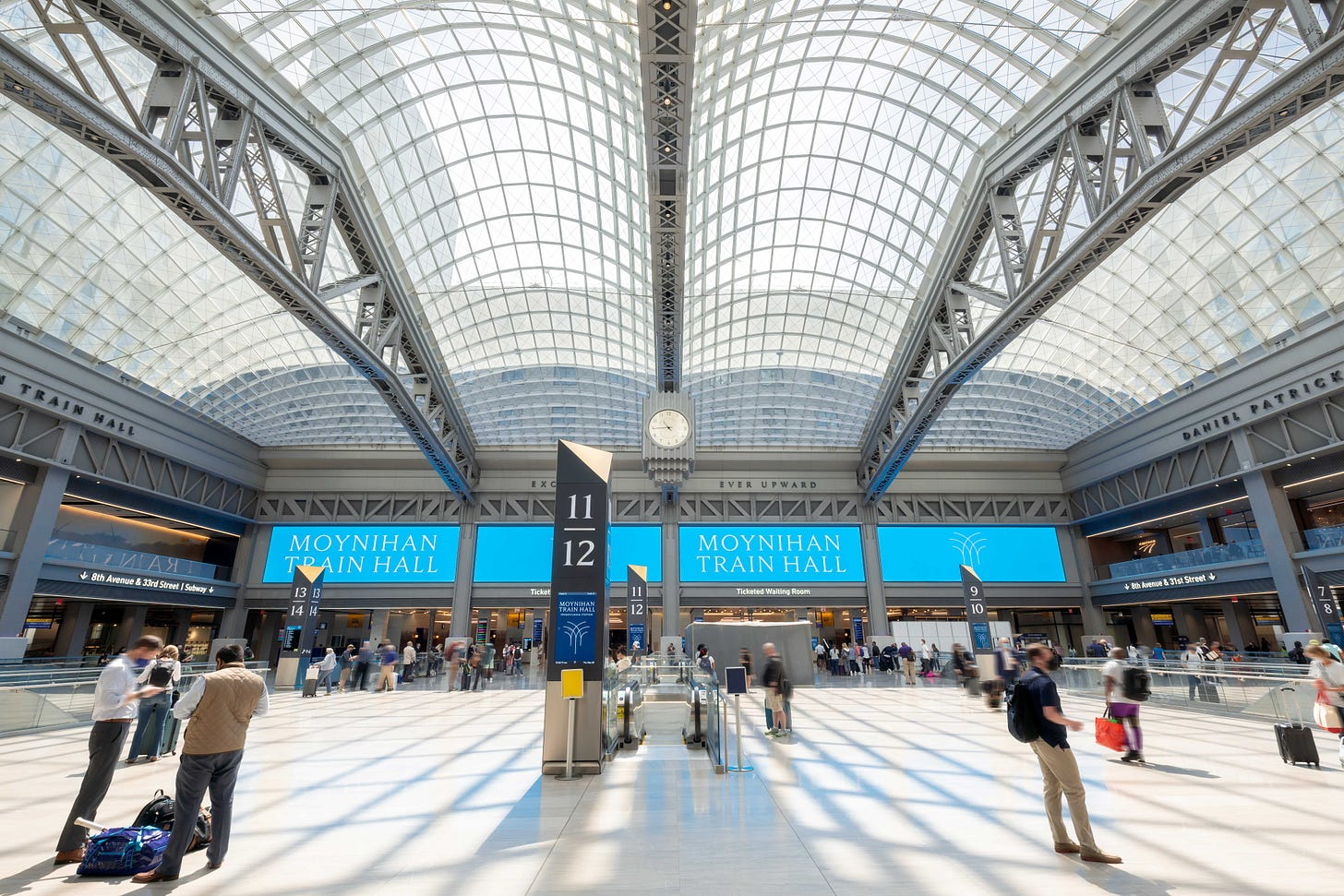Addressing Injustice Through (Lack of) Infrastructure Rather Than (Creation of) Policy
Immigration nerds, stick with me as I meander toward a point related to immigration policy
[May 1, 2023]: I had not been to the new Moynihan Train Hall in Manhattan until I recently took the train from New York to Washington, DC. The new train hall is a sleek addition to the miserably cramped and crowded Penn Station, an expansion into the city’s former main post office building, a beautiful Beaux-Arts structure designed by the renowned architecture firm McKim, Mead & White that originally opened in 1914.
The waiting area above the Amtrak train tracks—designed by another renowned architecture firm, Skidmore, Owings & Merrill—is large and bright, encased in a soaring 92-foot-tall glass and steel atrium with modernistic design allusions to some of the grand European train stations.
What immediately struck me, however, was that there was no place to sit.
I looked around and found that there is a lounge for first-class ticket holders taking the high-speed Acela, but I didn’t have a first-class ticket. There is another, fairly cramped waiting area for other ticket holders, with guards at the entrance to ensure that the unworthy are barred from entry.
But there were a lot of people standing around in the large open waiting area with briefcases, backpacks and small wheeled suitcases. One young woman sat down on the floor next to her backpack, and was quickly admonished by a uniformed employee and made to stand up again.
The reason for this design choice is sadly obvious. The powers that be wanted to ensure that the glossy new station didn’t become a place for homeless and other down-and-out people to congregate or to sleep overnight. It reminded me of the park benches that are built with arm rests strategically placed so that it is impossible to lie down. The underlying implications are also obvious but nonetheless hit me like a lightning bolt on this particular morning: rather than seeking to address the structural issues that leave significant portions of the U.S. population unhoused, we devote substantial resources toward constructing physical structures in our built environment to shunt the homeless population out of public view.
When did we become a nation that opts to tackle our homelessness problem not through policy but through architecture?
No Pathways to the Pathways
A similar dynamic is at play in a series of sweeping new measures the federal government has recently announced that are aimed to further reduce unlawful migration across the U.S.-Mexico border.
These measures include the government’s stated intention to work with the governments of Colombia and Panama to achieve three ridiculously ambitious goals over a period of 60 days: end the illicit movement of people through the Darién Gap; open up legal pathways for migrants;, and launch a plan to reduce the drivers of migration, including poverty and unemployment. (There was no mention of seeking to reduce other causes of migration such as government corruption, gang violence, drug trafficking, persecution, or climate change—I guess they figure that might take a bit longer than 60 days.)
There is a lot to unpack in these new initiatives, and I’m not going to engage in a detailed analysis of the new proposals here. But what strikes me in the wake of my “addressing-homelessness-through-architecture” epiphany is the government’s emphasis on what it calls “pathways.”
The main thrust of the new initiatives is to re-direct regional migration to “lawful pathways,” i.e., administrative processes that would permit a relatively small number of people to enter the United States lawfully for the purpose of seeking asylum or some other type of official immigration status. This includes opening up new regional immigration processing centers in Colombia and Guatemala. There is also a laundry list of punitive actions the federal government intends to deploy against migrants who fail to use the new pathways, including deeming people who circumvent lawful pathways presumptively ineligible for asylum.
There is an analogy to be made with how we deal with unhoused people. We address the shocking prevalence of homelessness in the United States not by tackling the reasons people are homeless (or giving them homes!), but by preventing them from mingling with the other humans in public spaces so as to keep them out of sight.
Similarly, we address the humanitarian needs of people uprooted from their homes and often fleeing for their lives not by truly tackling the root causes of migration but by building walls, erecting virtual roadblocks (aka processing centers) in other countries, and punishing migrants for not using government-sanctioned pathways for which most will not qualify.
Announcing an intention to shut down the Darién Gap for 60 days as a way to deter regional migration, or to punish people who circumvent the border wall because they cannot avail themselves of a limited array of new lawful pathways to immigrate, isn’t policy. It’s a charade composed of physical and virtual architecture. It’s shunting people away from public visibility into the hidden hazards of the desert, the clutches of the cartels, or the untenable conditions from which they fled in the first place.





